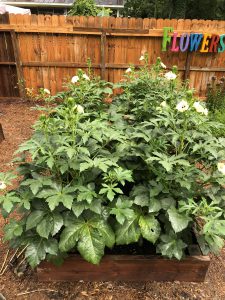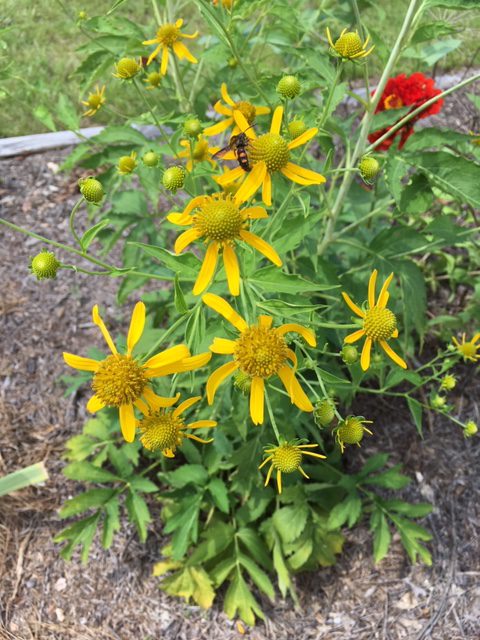

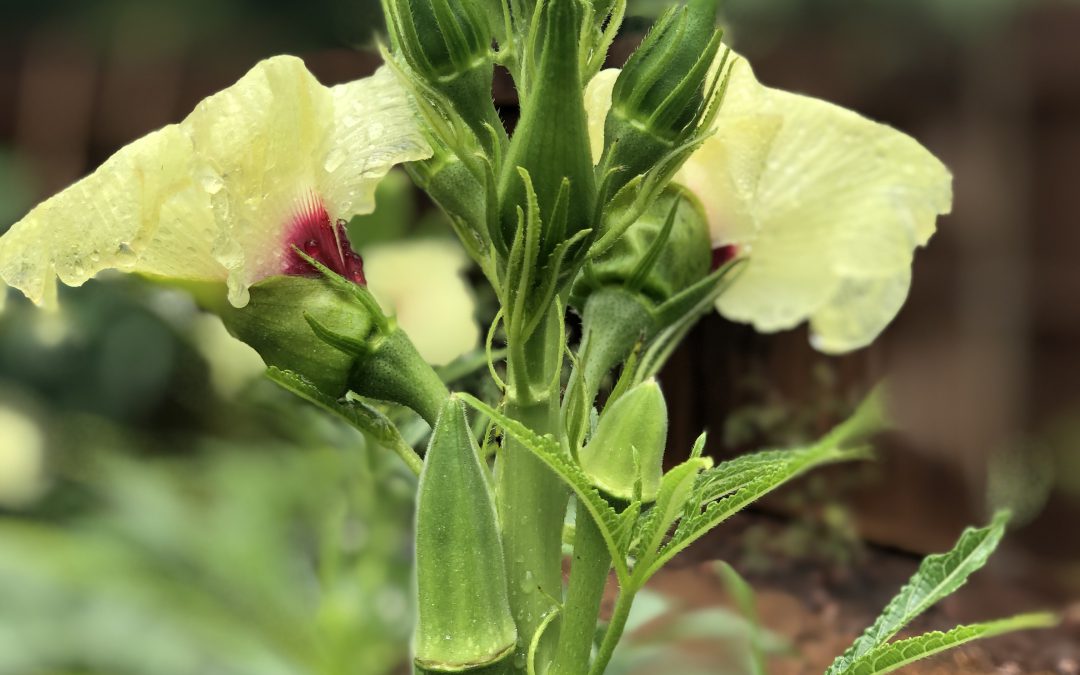
Add Some Cajun to Your Garden with ‘Jambalaya’ Okra!
Though Okra (Abelmoschus esculentus) fruit isn’t much more than a thick green hull, slime and seeds and the plant itself is impossibly irritating to the skin, few plants are as integral to Southern heritage. In my mind, okra is among the best vegetables Panhandle gardeners can grow. Not only is it a gorgeous plant – Okra belongs to the Mallow family which also includes beauties like Hibiscus and Cotton – but it’s exceedingly versatile in the kitchen, excellent fried, grilled, roasted, boiled (though you have to acquire a taste for slimy textures to enjoy this method) and most famously, as a thickening agent in Cajun gumbo. Because of this exalted status in Southern culture, whether you enjoy eating okra or not, it’s almost mandatory here to include the plant in one’s garden. Most gardeners stick with the old standard varieties such as ‘Clemson Spineless’ or ‘Cowhorn’ and there is nothing wrong with them, however, these plants are almost too prolific for most gardens (growing upwards of 6-7’), especially for those of us growing in the close confines of raised beds. In the search for a less rambunctious but still ultra-productive cultivar, this summer I trialed ‘Jambalaya’, an F1 hybrid developed by Sakata Seed in 2012, with impressive results!
From my experience growing the cultivar this summer, ‘Jambalaya’ merits consideration in the garden, and is a must for raised bed gardeners, for two primary reasons. First, it was bred to be compact and is considered a dwarf cultivar. This is an awesome attribute, as I typically end the growing season picking okra from a small ladder! Most seed purveyors tout the plant as reaching a maximum height of 3-4’ and while this estimate might be a little conservative, I can attest that ‘Jambalaya’ is greatly reduced in height compared to the standard cultivars. The second advantage of growing this variety is that it begins producing very early relative to its peers and bears heavily. ‘Jambalaya’ fruit begin to ripen in about 50 days, about ten days to two weeks earlier than ‘Clemson Spineless’, a definite advantage if rotating behind a late maturing spring crop like potatoes as I typically do. Though ‘Jambalaya’ is a dwarf plant, in no way are yields reduced. My specimens have produced continuously since late-July and will continue to do so as long as adequate fertility and consistent harvesting are provided.
Like any other okra cultivar, ‘Jambalaya’ has a couple of basic requirements that must be met for plants to thrive. In general, all okra cultivars love Southern summers and patience sowing seed is recommended, allow the soil to warm to at least 70 degrees before planting. Okra also prefers full sun, at least 6 hours per day, any less and yields will be reduced and plants will stretch towards the light. Belonging to the Mallow family, okra requires consistent moisture, particularly when in the flowering and fruiting phase. Finally, it is critical to keep up with your okra harvest as the plants produce! Okra pods grow quickly and should be harvested when they are no more than 3-4” long and still tender, larger pods are tough to the point of being inedible!
Whether you’re new to the okra growing game or you’re a seasoned gumbo gardener, I highly encourage you to give ‘Jambalaya’ Okra a look next summer. While ‘Jambalaya’ is available through many seed sources, Johnny’s Selected Seeds sells a conveniently small package perfect for backyard gardeners, though they’ll be happy to provide larger quantities as well. In ‘Jambalaya’ you’ll find a nice compact plant that won’t outgrow your space, provide you a summer long harvest of tender green pods, and will rival the ornamentals in your landscape for the title of prettiest plant on your property! Happy gardening and as always, if you have questions about vegetable gardening or any other horticultural or agronomic topic, please contact your local UF/IFAS County Extension office!
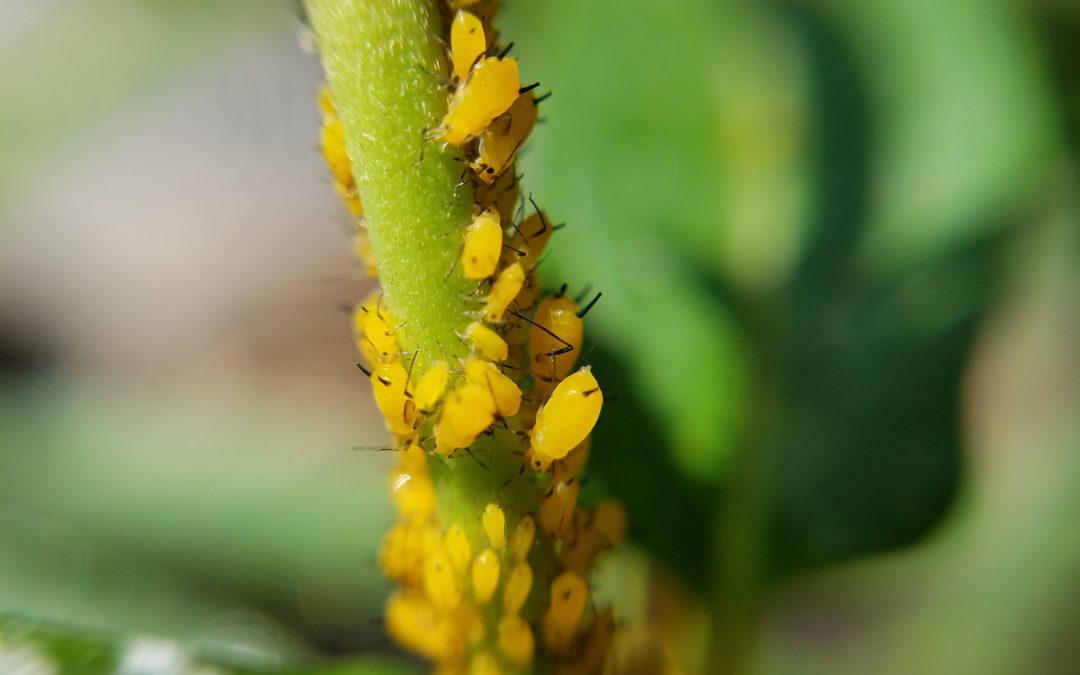
Insects in the Garden
By Evan Anderson, Walton County Agriculture Agent:
Gardening is an attractive pastime, not only for homeowners but also, it seems, for every critter out there that wants a free meal. If a gardener isn’t trying to keep deer, rabbits, or moles out of their crops, they’re fighting against insects of many
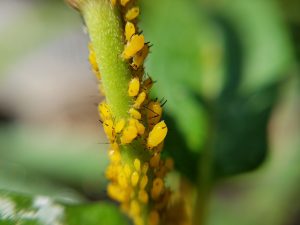
Aphids come in many colors, but are a common (and unwelcome) sight on garden plants. Photo courtesy Evan Anderson.
different sorts. With as many different sorts as there are, it can be dizzying to try and keep track of them and to figure out what’s doing damage to which vegetables.
Just because you see an insect in your garden doesn’t mean it’s a bad one. There are many that can be friends to a gardener, patrolling the plants to snack on pests. It’s important to know what you’re looking at before you try to control them; you might end up killing off a helpful bug instead of one that’s a problem!
It can be helpful to look at the damage done by the insects that are plaguing your garden to figure out what kind they are. Piercing / sucking insects drink the fluids from inside plant tissues, and leave small dots or stippling marks, and may exude honeydew, a stick fluid that sometimes grows sooty mold on
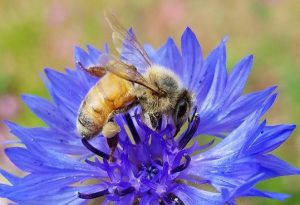
Honeybees are an example of a good bug to find in your garden. They help pollinate crops. Photo courtesy Evan Anderson.
it. These bugs include aphids, scales, mealybugs, spider mites, stink bugs, and thrips.
Chewing insects are those that usually go after plant leaves. They chew holes, and if an infestation is bad, they might defoliate a plant very quickly! Caterpillars, grasshoppers, and some beetles are the worst offenders of this sort.
If you need help identifying or figuring out how to control an insect in your garden or any other horticultural topic, feel free to contact your local UF/IFAS Extension office!
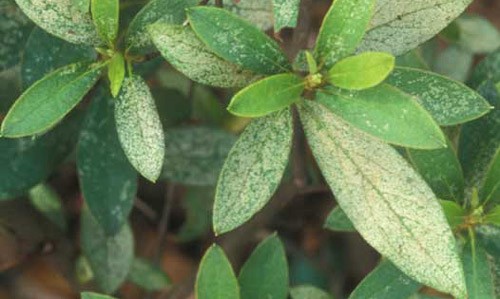
Why are the Azaleas “Bleaching Out”?
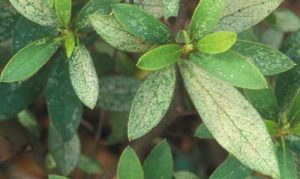
Damage caused by azalea lace bug, Stephanitis pyrioides (Scott), feeding. Photograph by James. L. Castner, University of Florida. Severely damaged leaves become heavily discolored and eventually dry or fall off. Symptoms may sometimes be confused with mite injury, but the presence of black varnish-like excrement, frequently with cast skins attached, suggest lace bug damage (Johnson and Lyon 1991).
You may be noticing the color disappearing from your azaleas right now. Do your azaleas look bleached out from a piercing-sucking insect. The culprit is probably azalea lace bug, Stephanitis pyrioides. This pest overwinters in eggs on the underside of infested leaves. Eggs hatch in late March and early April. The insect then passes through five nymphal instars before becoming an adult. It takes approximately one month for the insect to complete development from egg to adult and there are at least four generations per year. Valuable plants that are susceptible to lace bug damage should be inspected in the early spring for the presence of overwintering lace bug adults, eggs and newly-hatched nymphs. Inspect these plants every two weeks during the growing season for developing lace bug infestations.
Both adults and nymphs have piercing-sucking mouthparts and remove sap as they feed from the underside of the leaf. Lace bug damage to foliage detracts greatly from the plant’s beauty, reduces the plant’s ability to produce food, decreases plant vigor and causes the plant to be more susceptible to damage by other insects, diseases or unfavorable weather conditions. The azalea can become almost silver or bleached in appearance from the feeding lace bug damage.
However, lace bugs often go undetected until the infested plants show severe damage sometime into the summer. By then several generations of lace bugs have been weakening the plant. Inspecting early in the spring and simply washing them off the underside of the leaves can help to avoid damage later and the need for pesticides.
Adult lace bugs are flattened and rectangular in shape measuring 1/8 to 1/4 inch long. The area behind the head and the wing covers form a broadened, lace-like body covering. The wings are light amber to transparent in color. Lace bugs leave behind spiny black spots of frass (excrement).

Adult azalea lace bug, Stephanitis pyrioides (Scott), and excrement. Photograph by James. L. Castner, University of Florida.
Lace bug nymphs are flat and oval in shape with spines projecting from their bodies in all directions. A lace bug nymph goes through five growth stages (instars) before becoming an adult. At each stage the nymph sheds its skin (molts) and these old skins often remain attached to the lower surface of infested leaves.
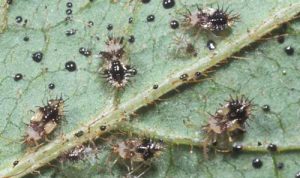
Nymphs of the azalea lace bug, Stephanitis pyrioides (Scott), with several cast skins and excrement. Photograph by James. L. Castner, University of Florida.
Azalea lace bug eggs are football-shaped and are transparent to cream colored. Lace bug eggs are found on the lower leaf surface, usually alongside or inserted into a leaf vein. Adult females secrete a varnish-like substance over the eggs that hardens into a scab-like protective covering.
Other plant species, such as lantana and sycamore, may have similar symptoms. But, realize that lace bugs are host specific. They feed on their favorite plant and won’t go to another plant species. However, the life cycle is similar. Be sure to clean up all the damaged leaves. That’s where the eggs will remain for the winter. Start next spring egg-free.
For more information go to: http://entomology.ifas.ufl.edu/creatures/orn/shrubs/azalea_lace_bug.htm

Japanese Plum Yews for the Landscape
We are always on the lookout for an attractive plant for our landscape. At the nursery, some plants have a more difficult time gaining our attention. They may not be as showy, possessing neither colorful flowers nor bold foliage. In these cases, we could be missing out on low maintenance plant that offers its own form of beauty in the right landscape spot.
One plant that I love is the Japanese plum yew (Cephalotaxus harringtonia), especially the spreading form ‘Prostrata’. In the nursery container, this plant is nothing special but once established in the landscape it performs well. The conifer type leaves are an attractive dark green and the ‘Prostrata’ selection is low growing to about 2 to 3 feet. An advantage too is that growth is slow so it won’t take over or require routine pruning.
Japanese plum yews grow best in partial shade and once established will be fine with rainfall. For a shadier side of the home, the spreading plum yew has a place as an evergreen foundation plant too.
If the ‘Prostrata’ selection is too low growing for you, consider the ‘Fastigiata’ cultivar that will grow upright to about 8 feet with a 5 foot spread.
Designing A Sensory Garden
Article by Rachel Mathes, Leon County Horticulture Program Assistant
Sensory gardens are a great way to involve children and people with special needs with gardening. Gardens provide a no-judgement zone for creative expression and allow us to get down in the dirt every now and then. Because sensory gardens are designed to be appreciated by more than just the sense of sight, they are an approachable way for disabled and non-disabled users alike. By engaging taste, feel, smell, hearing, and more, sensory gardens allow visitors of all ages and circumstances to engage in gardening.
To make your own sensory garden, think about what feeling you would like to experience while visiting your garden. Do you want a calm healing place of introspection or perhaps a vibrant playful area for engaged learning in nature? Having a theme can help you choose the different elements you would like to include in your sensory garden, which can be an entire yard or as small as a container. They are being used more and more in memory care units of nursing homes as well as preschools and elementary schools, but you can make your own right at home.
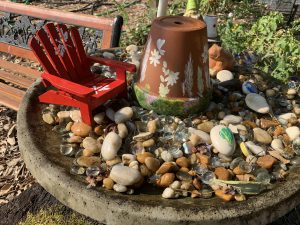
Water features provide enticing sounds for human visitors and a water source for wildlife. Can you spot the honeybee enjoying the fountain? Photo by Rachel Mathes.
The sound of moving water is calming to many, so a small fountain can be a great addition to your sensory garden. It will also benefit local wildlife by offering them a small watering hole. As long as the water is moving, mosquitos should not be a problem, but mosquito dunks or even the incorporation of mosquito fish are easy solutions to solving mosquito problems in small ponds or fountains. Some plants to consider for their sounds include false indigo (Baptisia australis), switchgrass (Panicum virgatum), and mountain oats (Chasmanthium latifolium). False indigo produces seed pods great for rattling, and when it is windy, switchgrass and mountain oats provide a gentle rustle.
A variety of textures offers the gardener a safe place to interact with nature without worrying about the dangers of poison ivy and other plant irritants. Plants like muhly grass (Muhlenbergia capillaris) offer a multitude of interactions as they sway in the wind, have bright white and pink blooms, and can be braided together in a variety of patterns. The native sunshine mimosa (Mimosa strigillosa) is a low growing ground cover that puts out pink powderpuff flowers and folds up when touched. Some other plants to explore by touch are lamb’s ear (Stachys byzantine), maiden grass (Miscanthus sinensis), the mildly dangerous points of aloe, and the many textures of southern magnolia (Magnolia grandiflora).
There are plenty of smelly plants to entice your nose in the garden. From rosemary to dill, mint and beyond, many herbs do very well here in the Florida Panhandle. Lemon balm and lemongrass bring a punch of citrus without the need for a big citrus tree. Beyond herbs, pine needles give a resinous scent when compressed, gardenias offer heavy sweetness from their voluminous white blooms, and sweet almond verbena (Aloysia virgata) delights with a vanilla almond aroma that carries pleasantly in the wind.
When it comes to tasting in a sensory garden, fruits and vegetables are an obvious choice. Plenty of annual vegetables can be grown year-round, from leafy greens in the fall, winter, and early spring, to tomatoes and peppers in the summer. Blackberries are an easy to grow favorite in this part of the state, are available as thornless varieties, and take well to growing on a trellis in small spaces. A great edible that many children favor in the Demonstration Garden at the Leon County Extension Office is cranberry hibiscus. The bright red leaves of new growth are a sweet and sour treat they equate to Sour Patch Kids candy. The older leaves can be added into stir fries and salads and the flowers can be cooked into a syrup for making purple lemonade. Herbs can be used for their taste factor as well. But if your sensory garden will be visited by the general public without supervision, I recommend clear delineation for the tasting area so that no one eats anything unpalatable or poisonous by accident.
When setting up your sensory garden, be sure to involve your intended audience. Small children thrive when given a job to do and will enjoy planting sweet herbs alongside you. Even regular maintenance of the garden can involve the participants you hope to engage. The simple acts of weeding and watering can foster a sense of responsibility and empowerment as the visitors gain sensory enrichment through these activities and see the fruits of their labor with time.
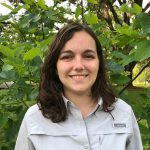 Rachel Mathes is the Horticulture Program Assistant for UF/IFAS Extension Leon County.
Rachel Mathes is the Horticulture Program Assistant for UF/IFAS Extension Leon County.

